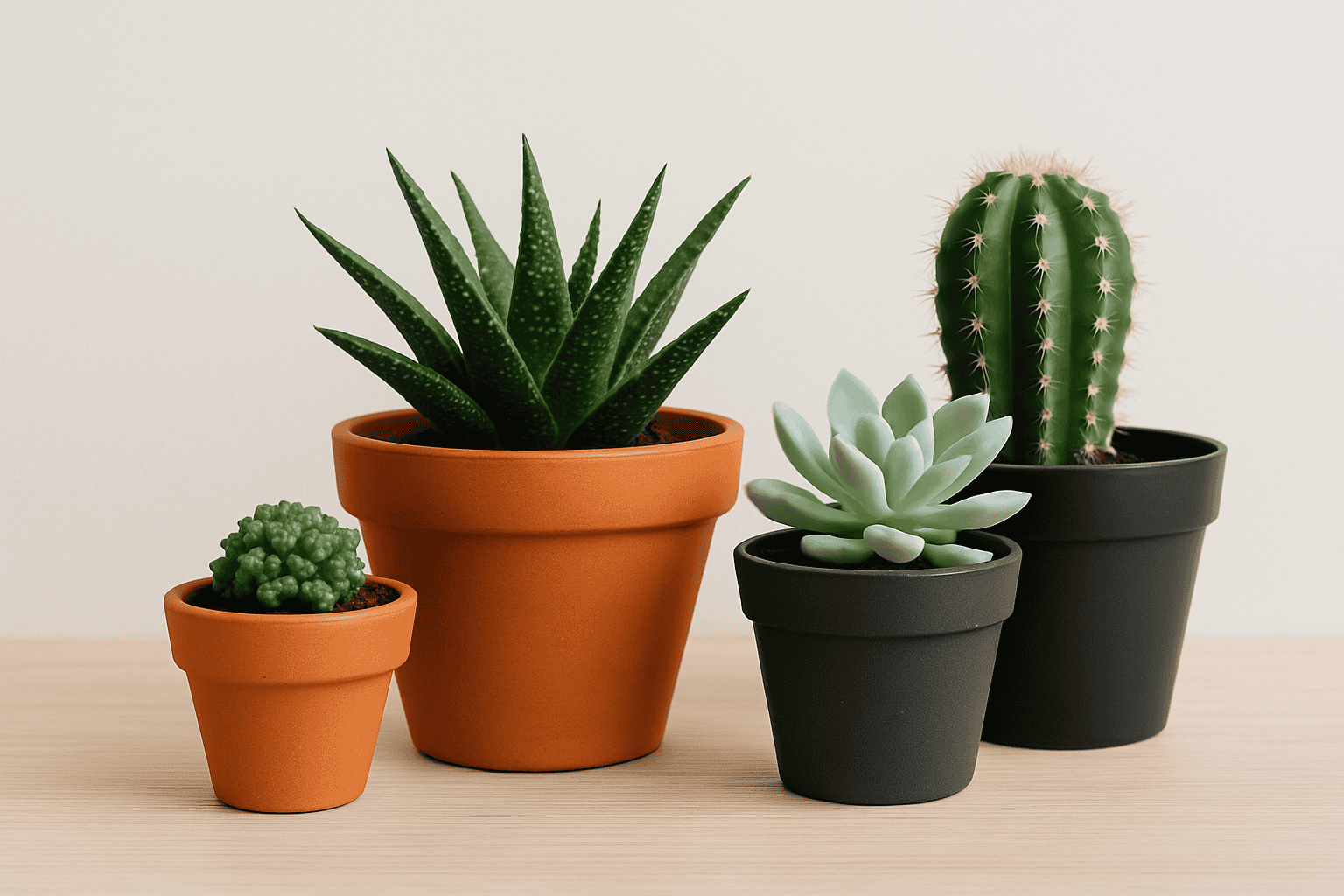Your cart is currently empty!
Terracotta vs Plastic Pots for Succulents: The Ultimate Guide
Choosing the right pot for your succulents is more than just an aesthetic decision. It impacts plant health, growth, and maintenance. In this comprehensive guide, we compare Terracotta vs plastic pots for succulents to help you make the best choice for your green companions—especially if you’re located in Belgium or the Netherlands. Understanding the nuances between these two popular options is essential for healthy plant care.

Understanding Terracotta Pots
What Are Terracotta Pots?
Terracotta pots are made from baked clay, giving them a distinctive reddish-brown hue. Their porous nature allows air and moisture to pass through the walls, promoting healthy root systems.
Advantages of Terracotta Pots
-
Breathability: The porous nature facilitates air circulation, preventing root rot.
-
Moisture Regulation: Excess water evaporates through the walls, reducing overwatering risks.
-
Temperature Control: They insulate plant roots, protecting them from extreme temperatures.
-
Aesthetic Appeal: Their natural look complements various interior and exterior designs.
Considerations When Using Terracotta Pots
-
Fragility: They can crack or break if dropped.
-
Weight: Heavier than plastic pots, making them less ideal for hanging plants.
-
Salt Buildup: Minerals can accumulate on the exterior over time.
Exploring Plastic Pots
What Are Plastic Pots?
Plastic pots are lightweight containers made from synthetic materials. They come in various colors, shapes, and sizes, offering versatility in design.
Advantages of Plastic Pots
-
Lightweight: Easy to move and rearrange.
-
Durability: Resistant to breakage and weather conditions.
-
Cost-Effective: Generally more affordable than terracotta pots.
-
Variety: Available in numerous designs to match any decor.
Considerations When Using Plastic Pots
-
Poor Breathability: Lack of porosity can lead to overwatering issues.
-
Heat Retention: Can cause soil to overheat, stressing the plant.
-
Environmental Impact: Not biodegradable and can contribute to plastic waste.
Comparative Analysis: Terracotta vs Plastic Pots for Succulents
| Feature | Terracotta Pots | Plastic Pots |
|---|---|---|
| Breathability | High – promotes air circulation | Low – can trap moisture |
| Weight | Heavy – stable but less portable | Light – easy to move |
| Durability | Fragile – prone to cracking | Durable – resistant to breakage |
| Aesthetic Appeal | Natural, rustic look | Varied – available in many designs |
| Cost | Moderate to high | Generally low |
| Environmental Impact | Eco-friendly – biodegradable | Less eco-friendly – contributes to plastic waste |
Best Practices for Succulent Care in Different Pots
Using Terracotta Pots
-
Watering: Requires more frequent watering due to evaporation.
-
Placement: Ideal for outdoor settings or sunny indoor spots.
-
Soil: Use well-draining soil to prevent moisture retention.
Using Plastic Pots
-
Watering: Less frequent watering needed; monitor soil moisture.
-
Placement: Suitable for shaded areas or indoor settings.
-
Soil: Ensure soil has good drainage to avoid waterlogging.
Succulux.be: Your Go-To Online Plant Store in Belgium and the Netherlands
Looking to buy plants online in Belgium or the Netherlands? Succulux.be offers a curated selection of mini cacti, succulents, and modern plant pots. Whether you’re a seasoned gardener or a beginner, Succulux.be provides quality products and expert advice to help your plants thrive.
If you’re looking to buy plants online Belgium or buy online plants with confidence, Succulux.be is the trusted destination for plant lovers.
Frequently Asked Questions
1. Can I use terracotta pots for all types of plants?
Terracotta pots are ideal for plants that prefer drier conditions, such as succulents and cacti. However, they may not be suitable for moisture-loving plants due to their porous nature.
2. How often should I water succulents in plastic pots?
Since plastic pots retain moisture longer, it’s essential to check the soil’s dryness before watering. Typically, watering once every two weeks is sufficient, but this can vary based on environmental conditions.
3. Do terracotta pots need drainage holes?
Yes, drainage holes are crucial in terracotta pots to prevent water accumulation at the bottom, which can lead to root rot.
4. Are plastic pots safe for edible plants?
While many plastic pots are safe, it’s essential to ensure they are made from food-grade materials if you plan to grow edible plants.
5. How can I clean mineral deposits off terracotta pots?
Soak the pot in a mixture of vinegar and water, then scrub gently with a brush to remove the white mineral buildup.
6. Which pot type is better for indoor plants?
Both terracotta and plastic pots can be used indoors. The choice depends on the plant’s moisture needs and your aesthetic preference.
Conclusion
Choosing between terracotta and plastic pots depends on various factors, including plant type, environmental conditions, and personal preferences. Terracotta pots offer breathability and a natural look, making them ideal for succulents and cacti. On the other hand, plastic pots provide versatility and durability, suitable for a wide range of plants. For residents in Belgium and the Netherlands, Succulux.be is your trusted online destination to buy plants and pots that cater to your gardening needs.
Leave a Reply